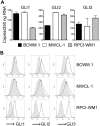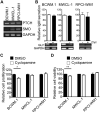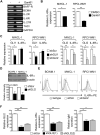Modulation of the IL-6 Receptor α Underlies GLI2-Mediated Regulation of Ig Secretion in Waldenström Macroglobulinemia Cells
- PMID: 26238488
- PMCID: PMC4561187
- DOI: 10.4049/jimmunol.1402974
Modulation of the IL-6 Receptor α Underlies GLI2-Mediated Regulation of Ig Secretion in Waldenström Macroglobulinemia Cells
Abstract
Ig secretion by terminally differentiated B cells is an important component of the immune response to foreign pathogens. Its overproduction is a defining characteristic of several B cell malignancies, including Waldenström macroglobulinemia (WM), where elevated IgM is associated with significant morbidity and poor prognosis. Therefore, the identification and characterization of the mechanisms controlling Ig secretion are of great importance for the development of future therapeutic approaches for this disease. In this study, we define a novel pathway involving the oncogenic transcription factor GLI2 modulating IgM secretion by WM malignant cells. Pharmacological and genetic inhibition of GLI2 in WM malignant cells resulted in a reduction in IgM secretion. Screening for a mechanism identified the IL-6Rα (gp80) subunit as a downstream target of GLI2 mediating the regulation of IgM secretion. Using a combination of expression, luciferase, and chromatin immunoprecipitation assays we demonstrate that GLI2 binds to the IL-6Rα promoter and regulates its activity as well as the expression of this receptor. Additionally, we were able to rescue the reduction in IgM secretion in the GLI2 knockdown group by overexpressing IL-6Rα, thus defining the functional significance of this receptor in GLI2-mediated regulation of IgM secretion. Interestingly, this occurred independent of Hedgehog signaling, a known regulator of GLI2, as manipulation of Hedgehog had no effect on IgM secretion. Given the poor prognosis associated with elevated IgM in WM patients, components of this new signaling axis could be important therapeutic targets.
Copyright © 2015 by The American Association of Immunologists, Inc.
Figures







Similar articles
-
IL-21 in the bone marrow microenvironment contributes to IgM secretion and proliferation of malignant cells in Waldenstrom macroglobulinemia.Blood. 2012 Nov 1;120(18):3774-82. doi: 10.1182/blood-2012-03-419440. Epub 2012 Sep 13. Blood. 2012. PMID: 22976953
-
Regulation of interleukin-6 and interleukin-6R alpha (gp80) expression by murine immunoglobulin-secreting B-cell hybridomas.Immunology. 1998 Apr;93(4):498-504. doi: 10.1046/j.1365-2567.1998.00460.x. Immunology. 1998. PMID: 9659221 Free PMC article.
-
IL-3 and granulocyte-macrophage colony-stimulating factor strongly induce Ig secretion by sort-purified murine B cell activated through the membrane Ig, but not the CD40, signaling pathway.J Immunol. 1995 Jun 1;154(11):5842-50. J Immunol. 1995. PMID: 7538533
-
Waldenström macroglobulinemia.Hematol Oncol Clin North Am. 2014 Oct;28(5):945-70. doi: 10.1016/j.hoc.2014.06.003. Epub 2014 Aug 5. Hematol Oncol Clin North Am. 2014. PMID: 25212891 Review.
-
Waldenström macroglobulinemia: from biology to treatment.Expert Rev Hematol. 2014 Feb;7(1):157-68. doi: 10.1586/17474086.2014.871494. Epub 2014 Jan 3. Expert Rev Hematol. 2014. PMID: 24405328 Review.
Cited by
-
Macrophage Polarization States in the Tumor Microenvironment.Int J Mol Sci. 2021 Jun 29;22(13):6995. doi: 10.3390/ijms22136995. Int J Mol Sci. 2021. PMID: 34209703 Free PMC article. Review.
-
GLI3 Is Required for M2 Macrophage Polarization and M2-Mediated Waldenström Macroglobulinemia Growth and Survival.Int J Mol Sci. 2024 Dec 6;25(23):13120. doi: 10.3390/ijms252313120. Int J Mol Sci. 2024. PMID: 39684827 Free PMC article.
-
A novel mechanism of regulation of the oncogenic transcription factor GLI3 by toll-like receptor signaling.Oncotarget. 2022 Aug 3;13:944-959. doi: 10.18632/oncotarget.28261. eCollection 2022. Oncotarget. 2022. PMID: 35937499 Free PMC article.
-
GLI3: a mediator of genetic diseases, development and cancer.Cell Commun Signal. 2020 Apr 3;18(1):54. doi: 10.1186/s12964-020-00540-x. Cell Commun Signal. 2020. PMID: 32245491 Free PMC article. Review.
-
Epigenetic targeting of Waldenström macroglobulinemia cells with BET inhibitors synergizes with BCL2 or histone deacetylase inhibition.Epigenomics. 2021 Jan;13(2):129-144. doi: 10.2217/epi-2020-0189. Epub 2020 Dec 24. Epigenomics. 2021. PMID: 33356554 Free PMC article.
References
-
- MacLennan ICM. Germinal Centers. Annual Review of Immunology. 1994;12:117–139. - PubMed
-
- Heyman B. Regulation of Antibody Responses via Antibodies, Complement, and Fc Receptors. Annual Review of Immunology. 2000;18:709–737. - PubMed
-
- Slifka MK, Antia R, Whitmire JK, Ahmed R. Humoral Immunity Due to Long-Lived Plasma Cells. Immunity. 1998;8:363–372. - PubMed
-
- Kyle RA, Rajkumar SV. Multiple myeloma. 2008.
Publication types
MeSH terms
Substances
Grants and funding
LinkOut - more resources
Full Text Sources
Other Literature Sources
Research Materials

